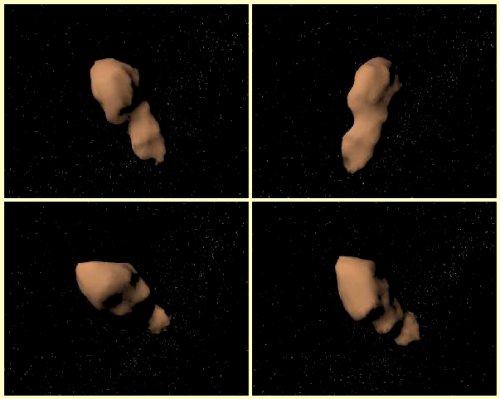Asteroid Update
Today, asteroids, real and imagined. The University of Houston's College of Engineering presents this series about the machines that make our civilization run, and the people whose ingenuity created them.
Two articles in a recent Science magazine deal with the threat to Earth by asteroids and meteorites. The first is about a NASA-sponsored workshop on asteroids. So far, NASA has searched out 635 asteroids larger than a kilometer across. However they estimate that almost twice that number might be out there, orbiting the sun.
They hope to have ninety percent of those really big asteroids identified by 2008. The mile-and-a-half by three-mile asteroid Toutatis (large enough to've eliminated human life on Earth) had us concerned for a while. We finally determined that it'll miss Earth by a "mere" million miles in 2004.
Of course, NASA's catalog of large asteroids doesn't begin to capture the tens of thousands of smaller objects out there. They include asteroids that could obliterate major cities or launch three-hundred-foot tidal waves.
So how serious is this threat? History answers that question: Asteroids a kilometer or more across have hit Earth every few hundred-thousand years, rearranging the balance of species when they do. Asteroids as large as two-tenths of a mile in diameter hit us every sixty thousand years. So the problem is real enough, even if we're very unlikely to see a major collision in our lifetimes.
Still, the consequences would be so horrific that we'd be crazy to ignore such catastrophes. And here the fun begins: What means should we pursue to protect ourselves?
We can't rest on any one-size-fits-all solution. Some asteroids might be blown up and scattered. Others might have to be nudged into a new orbit by some sort of jet. Some are tight clusters of loose rock. I'll leave you to think of means for diverting something like that. The problem is real, large, and varied.
So we turn to the other Science article. Scientists are revisiting the Tunguska explosion. In 1908, it flattened trees and killed herds of animals over the thinly populated Tunguska Forest in Siberia -- roughly the area of Rhode Island. For days afterward, the resulting dust-cloud cast an eerie light all around the world. We estimate that the Tunguska meteor was about ninety feet in diameter.
However, the blast left no crater. It seems to've occurred five or six miles up, and the forest directly below was left untouched. Furthermore, no meteorite fragments were ever found. It is a story that somehow never quite added up.
It turns out that a huge natural-gas deposit lies directly below the blast site. Now these scientists wonder if a large gas leak from the deposit could have combined with the right atmospheric conditions to create an immense gas bomb.
And so nature is large. It has the capacity for turning upon us from without or from within. To stay alive, we must (as we always have) employ an ongoing and aggressive curiosity about the immensities of all that is around us.
I'm John Lienhard, at the University of Houston, where we're interested in the way inventive minds work.
(Theme music)
Kerr, R. A., A Little Respect for the Asteroid Threat. Science, Vol. 297, 13 September 2002, pp. 1785-1787. See also, More Theories on Tunguska. Science, Vol. 297, 13 September 2002, pg. 1803.
For more on the problem of orbiting space junk, see Episode 1714.

Four views of the asteroid Toutatis. (Image courtesy of NASA)